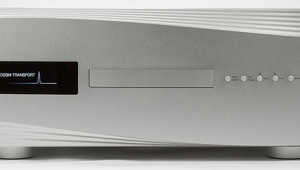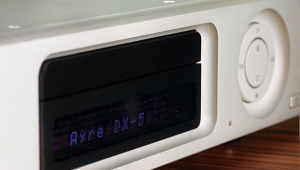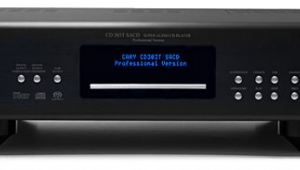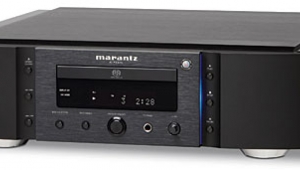| Columns Retired Columns & Blogs |
Esoteric SA-60 universal player
In the ongoing debacle that has been the introduction and promotion of high-resolution digital audio and the record industry's struggles to engage the public's interest in it, two recent events stand out.
Footnote 1: The depth of the pits on a disc's surface should be one quarter of the wavelength of the laser light, meaning that when read from directly above, there will be complete destructive interference with light reflected from the pits, but not the lands, maximizing the dynamic contrast. This contrast is reduced when the pits are read from an angle.—John Atkinson
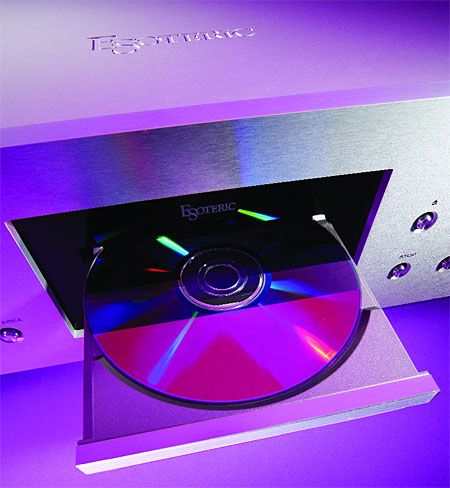
One was Sony's decision, in 2006, to limit to one day a week the production of hybrid SACD/CDs at its Terre Haute, Indiana pressing plant, which had opened with much fanfare in May 2003. That forced ABKCO Records to replace its catalog of Rolling Stones hybrids, perhaps the best-selling SACD/CDs ever released, with "Red Book" CD editions. According to ABKCO, the company had found itself unable to fill wholesale orders.
Removing the SACD layer wasn't a big issue for ABKCO—few consumers were buying the discs to get the SACD layer in the first place, the label had designed the artwork to underplay SACD to avoid consumer confusion, and, most important, had priced the discs to ensure that they'd be stocked in the CD racks and not in some "audiophile" ghetto hidden behind a wall. But Sony's move drove the last nail into the coffin of the optimistic notion that the hybrid disc's "hidden" SACD layer might make it a mainstream product costing no more than a "Red Book" CD. Sony's message, heard loud and clear throughout the industry, was that no independent label's effort to support the SACD format with superb sound, a popular catalog, and low prices would go unpunished by SACD's inventor and original promoter.
The other high-resolution setback was Philips' launch, in 2005, of a poorly designed, ergonomically primitive OEM SACD transport. Aside from refusing to play a large percentage of "Red Book" CDs that any $30 DiscMan would play without so much as a digital hiccup, this transport eventually produced an almost 100% failure rate in the field with no possible fix—much to the disgust, horror, and embarrassment of Krell, Musical Fidelity, T+A, and other makers of high-end players who value their reputations for making reliable, high-quality players. Philips then made matters worse by simply abandoning their manufacturer customer, leaving these companies to face angry customers who'd bought expensive products that broke and could not be fixed.
Add the problems in navigating DVD-Audio discs with displayless, audio-only systems, the limited enthusiasm among audiophiles for multichannel sound, the record industry's confusing move to double-sided DualDiscs containing CD, Dolby Digital, and DVD-A content, consumers' clamor for lo-rez MP3 downloads, and the resurgence of analog, and it's a wonder that hi-rez digital sound has survived at all.
Yet, like vinyl, high-resolution digital has survived, thanks to the support of enthusiasts like the readers of Stereophile. A perusal of retail websites catering to audiophiles demonstrates that there's sufficient high-quality music available in the two hi-rez audio formats to make the purchase of a "universal player" worth considering—assuming that that player offers superb CD playback. For now (and perhaps forever), the vast majority of digitally encoded music on disc will be in the standard "Red Book" format.
Proprietary VOSP transport
Esoteric's product line includes audio-only CD transports costing $13,300 and $25,000, and stereo and monoblock DACs costing $13,300 and $25,000/pair, respectively. At $4600, the SA-60 is second from the bottom of Esoteric's audio-only offerings, yet has a highly advanced, proprietary transport that Esoteric has developed, using the same optics, from the X-3 series of VRDS transports used in the company's more expensive players.

The mechanism—a sophisticated, Vertically Aligned Optical Stability Platform (VOSP)—is claimed to offer levels of rigidity and stability not found in cheaper plastic transports, as well as a high-mass disc-clamping system that reduces rotational resonances at high speeds. The disc is clamped between a plate and an 8mm-thick, large-diameter disc, both made of metal.
This rigid, stable framework permitted the development of a shaft-mounted laser-pickup assembly of equal rigidity and stability, that maintains perfect vertical alignment to ensure that the laser's optical axis is always centered in the data track. [According to the SA-60's manual, the actual optical pickup is sourced from Sony, an SLD6163RL-G—Ed.] Conventional laser-pickup assemblies are allowed to pivot in order to keep the laser beam in contact with the spiral data track. In cheaper transports, the high-speed rotation of the disc causes unwanted resonances that can shake both the disc and the laser head. According to Esoteric, data read when the laser is off its central axis is liable to high levels of jitter and errors. The VOSP transport's reduction of tracking error and claimed elimination of off-axis data reading are claimed to result in far less jitter and error correction.
The transport mechanism is mounted directly on the bottom of the chassis with a pair of steel brackets, to provide additional rigidity to further damp resonances. The disc tray itself is made of aluminum, not plastic. A picture of the VOSP mechanism speaks volumes about its robust mechanical design when compared to the typical plastic transports found in most CD, SACD, DVD, and universal players.
But how much difference can all of this mechanical stability and "perfect tracking" make to digital sound? Why should it make any difference at all?
Many audiophiles forget that an optical disc is actually an analog format—the digital code itself is not engraved in the disc. Instead, the disc's "land" and "pit" surfaces are physical analogs of the digital bitstream's ones and zeros. As the laser beam is reflected off a land or a pit, the amount of reflected light reflected determines whether the information is read as a one or as a zero.
A CD pit is intended to absorb light; the laser's "direct hit" on a pit is more likely to provide greater absorption of the beam, and thus a greater likelihood of the pit's being read correctly, than the "partial hit" of an off-axis strike (footnote 1). While error-correction circuitry can extrapolate and fill in missing data, better tracking should result in fewer reading errors, and thus less interpolation, less jitter, and better sound when the data is converted to an analog signal.
Digital Conversion
Once the SA-60's transport has read data from a CD, SACD, DVD-A, DTS, DTS 96/24, or Dolby Digital disc, it then feeds those data to the player's Cirrus Logic CS4398 digital-to-analog converters. These DACs are capable of natively converting the SACD format's native DSD encoding, as well as converting PCM data. (Some SACD players' DACs convert DSD to PCM before presenting it to the DACs.) In keeping with Esoteric's purist intentions, the SA-60 has separate DACs for its two- and 5.1-channel outputs.
The SA-60 employs the second generation of Esoteric's proprietary RDOT and FIR algorithms, which give the user a variety of reconstruction filters. The player also includes the option of upconverting CD PCM data to DSD, as used in Esoteric's far more expensive P-03/D-03 separates.
The rear-panel jacks include separate two-channel and multichannel outputs and a pair of balanced XLR outputs. There are also coaxial and optical digital outs, and a BNC word-sync input for use with an external word clock. (Esoteric offers several dedicated master-clock devices including one, the G-0S, which features a rubidium clock generator.) An optional iLINK (IEEE1394, or FireWire) port outputs DSD and high-resolution PCM, both stereo and multichannel, for decoding via an outboard DAC. The remote control, milled from a block of aluminum, exudes high quality, though it's not backlit.
All things considered, the reasonably priced SA-60 makes an unreasonably fine physical impression in terms of both build quality and functionality.
Setup and Use
Japanese-made components often come with frustratingly incomplete and/or confusing instruction manuals, and the SA-60 is no exception. For instance, its manual's "Up convert" section tells you that "An FIR digital filter...does upward sample rate conversion," and that you can "select wide or narrow characteristic for this filter. See page 20 for details." On p.20 you are told how to "Choose either 'Wide' or 'Narrow,'" but not a word about what that means, or what the sonic consequences of choosing either option might be.
Footnote 1: The depth of the pits on a disc's surface should be one quarter of the wavelength of the laser light, meaning that when read from directly above, there will be complete destructive interference with light reflected from the pits, but not the lands, maximizing the dynamic contrast. This contrast is reduced when the pits are read from an angle.—John Atkinson
- Log in or register to post comments

